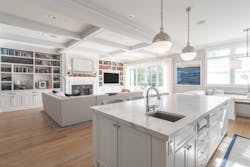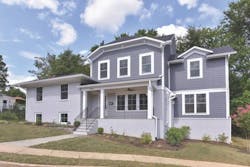Local Builder, Global Reach
Despite industry-wide shortages and supply chain disruptions, Winter is developing a growing customer base in Northern Virginia with innovative custom builds and home renovations that make him a key player in his local market.
As co-founder of the Paradigm Foundation, a registered nonprofit that builds homes for families living in extreme poverty, Winter has also expanded his construction services to improve living conditions for families in under-developed countries across the globe. In a transformative time for the building industry, Winter’s philanthropic values serve as a hopeful reminder of the wider impact custom builders can have as mindful industry leaders and community pioneers.
How did you get started with Paradigm Homes? What type of work does your company do?
I started Paradigm Building Group in 2007 as everything was coming to a crashing halt in the residential construction world. We did some commercial work for a while, but in the last four or five years we’ve made a switch to Paradigm Homes and really focused on custom homes, large additions, and renovations.
I used to work for a national builder, NVR, and I was there for about seven years. But starting in 2006, as things were changing and shifting, I began to see the writing on the wall. I realized I had a passion for doing my own thing, like going out and building one or two houses on my own. So I stepped out to do that instead and really didn’t build my first custom home until about four years later.
Over the years, our work ebbed and flowed and we found our niche with design/build. We focus on making sure the client is part of the process so we can produce thoughtfully designed custom homes for the buyer’s profile. Clients may not love 100% of a spec home or homes with layouts or design features that aren’t compatible with their style. At Paradigm Homes, we use a program and process that gives clients a unique experience so they can design a home they will love 100%.
How does Paradigm Homes bring on new clients? Walk us through the design process.
There are many ways to find us. We’re on Instagram and Facebook, and clients can also find us at our website, paradigmhomes.com. We use a lot of strategic partners in our market—Realtors, lenders, and other affiliates—who help with referrals, as well as past clients who pass along information to friends, family, and neighbors. It starts at that small level of marketing, and from there clients will connect with our head of business development and he’ll walk them through the process to clarify what they’re looking for, what their budget is, and what their goals are, to see if we’re the right fit. We currently have a good backlog of projects, so we’re making sure we can fit all of our clients into the right time line. We really want to understand who they are and what’s important to them.
Paradigm Homes not only does custom building projects but is also the “pop-top” leader in its market. Could you explain what a pop-top renovation is and how it can enhance a home?
A “pop top” is our way of saying a “second-story addition.” We take the little ramblers and ranches that are in good shape up and down the East Coast and we basically pop the top. We take the roof off and add a second level, so we’re keeping the existing footprint and using the components that are already in the home and the existing foundation, maybe even the existing walls or existing windows, depending on the client’s budget. It’s a good way to economically enhance a structure that’s already in place to really help our clients maximize their budget while also designing something that fits their current lifestyle, whether that involves open floor plans, taller ceilings, bigger windows, larger doors, or other renovations. Pop tops provide a great canvas for working within a client’s budget.
It’s my understanding Paradigm’s interest in pop tops came as a result of the low availability of empty lots in your area. Can you elaborate on the severity of the land shortage, challenges stemming from it, and why you think pop tops are a good solution?
Land seems to be a challenge everywhere right now. We call ourselves more of an infill developer/builder, so we go into existing homes in existing neighborhoods and give our clients the ability to stay where they are. Maybe they don’t want to move out or they can’t afford to do a total renovation. Pop-top additions address the client’s budget and allow them to stay among their friends, families, schools, and workplaces if they don’t have the ability to take the route of new construction.
What advice would you give to remodelers and builders facing the same issue? Are pop tops a good solution everywhere?
Yes and no. A lot of builders struggle with similar additions because they require more work and there’s a lot more thought that goes into them. They involve more design to make sure the existing structure is up to today’s codes. We typically also have to update mechanical, electrical, and plumbing systems, so pop tops can be a great alternative depending on whether builders have a process in place to take on a project to that extent. If any builders out there want some advice, we’d be glad to share and walk through the challenges and hurdles that have helped us perfect our process.
Your building projects and nonprofit work are community-oriented and geared toward helping homeowners improve their lifestyles through new-home construction and renovations. In what ways do you believe the construction industry can help repair or revitalize communities? And where does your interest in such work originate and how does it shape the way you run your business?
The work we do isn’t just about us or about Paradigm. It’s about those less fortunate around the world who we want to give back to. We have the ability to serve our clients in Northern Virginia well and we just launched a new division in Charleston, S.C., so being able to assist our clients at home is something we value and it also gives us the ability to go serve others around the world.
Giving back is something that has been a core value for me and my wife. From the inception of Paradigm, we’ve always had the vision of doing something greater. We wanted to create a lasting impact, and one of the ways we can do that is with the Paradigm Foundation through our ability to serve alongside those in extreme need.
Right now, the Paradigm Foundation serves the ultra-poor—those living on less than $2 a day. We started the foundation a little more than seven years ago in the Dominican Republic. Now we’re in Kenya, the Central African Republic, and we just launched a new partnership in Brazil. We’ve built over 50 homes and one church, and hopefully we’ll be expanding to more countries as more opportunities arise through Paradigm Homes and the Paradigm Foundation.
What are some of your hopes for the future of the building industry? In light of the pandemic, what changes do you expect to see both in your local community and on a wider scale in years to come?
I think we’re going to have some challenges for a while. We’re all dealing with supply-chain issues and we have been for quite some time. We can try to be proactive by shifting the way we order building materials to be prepared months in advance. We have skilled labor shortages, land shortages, and also a shortage of skilled project management. Most builders are fortunate enough to stay busy because the demand is there and more people are building due to the great interest rates, so they have the opportunity to expand their budgets to do a bit more.
As we progress, I think we as builders have a good ride ahead of us, and I feel confident in our ability to grow and sustain. At the same time, we’re also providing something the community needs, especially in the neighborhoods where we serve. We’re going into existing neighborhoods and revitalizing them through our custom homes, pop-top addition projects, or through other opportunities we provide. One of our other core values as builders is to be good neighbors. We don’t want to be messy builders and disrupt the neighborhoods where we work. We want to be thoughtful and mindful about how we conduct our work. As things progress, I hope other builders will do the same.
Being a good neighbor is a good way to serve the community and could even help you earn the next client down the street.

